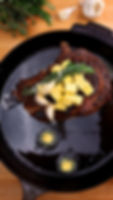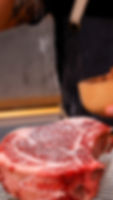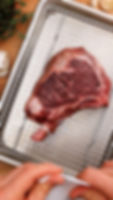How To Cook Steak Like A Steakhouse
- Ryan
- Mar 19
- 4 min read
Updated: 5 days ago
This post may contain affiliate links.
Putting a steakhouse-quality touch on a home-cooked steak takes a few essential steps. This recipe will show you how to pan-sear a ribeye steak at home like a fancy steakhouse. Pair this steak with one of our homemade Compound Butters.

The Science of Salt on Steak
Salt is one of the most important seasonings for steak. Not only for flavor, but it is key for achieving a perfect seared crust while maintaining a juicy, well-seasoning interior.
The trick with salt is it facilitates a process called osmosis. This is just a fancy word for describing how moisture is drawn from the inside of the steak to its surface. Because of this, the time at which salt is added is important.
If we salt far enough in advance, some of this moisture will evaporate and the remainder will seep back into the steak. The added benefit of preparing the steak in advance is the surface of the steak can dry out a bit which is important for getting a crispy seared texture on the steak during cooking. However, salting too close to cooking can cause problems.
Within just about 3-5 minutes, salt will pull enough moisture to the surface to make searing the steak much less effective. So for the best results, season your steak generously with kosher salt about 12-24 hours in advance and let it brine in the refrigerator on a wire rack. The wire rack will allow air to more evenly circulate around the steak to allow it to dry slightly and prevent brown spots.
NOTE: If you're cooking a thin steak (less than 1.5 inches thick), pre-salting is not necessary.
Dry off any surface moisture from the steak, re-season with kosher salt and black pepper if you like, and immediately start searing it before more moisture can draw out.


WHAT YOU'LL NEED (scroll to full ingredient list)
Spoon
Black pepper
Butter
Garlic
Compound butter
High-heat neutral cooking oil
DIRECTIONS
STEP 1: PREP
Liberally season steak with kosher salt and refrigerate on a wire rack for 12-24 hours.
To help evenly distribute the salt, season from about 12 inches above the steak.
Trussing the steak with butcher's twine helps keep the steak's natural shape when handling. The twine should be snug, but not so tight that it cuts into, or deforms the steak
STEP 2: TEMPER
Let steak rest at room temperature for about 45 minutes.
Optionally, wrap the bone with foil to keep it white.
STEP 3: SEASON
Preheat oven to 450°F.
Preheat the skillet over medium-high heat for about 5 minutes to get it to about 450°F.
Dry steak with a paper towel to remove all surface moisture.
Season steak with kosher salt immediately before searing (no earlier than 3 minutes).
Optionally, season with coarse black pepper.
STEP 4: SEAR
Add about 1/4-inch of oil to skillet. When the oil begins to smoke, place the steak in the skillet.
WARNING: Hot oil can seriously burn you. Make sure to gently lay the steak away from you to avoid splashing in your direction.
Sear for 4-5 minutes until the crust is formed and the color is dark brown.
A thick steak (about 2 inches) is best for getting a proper sear without overcooking the interior. Thin steaks are easy to overcook.
Flip the steak and repeat.
Reduce heat to medium-low and carefully discard the oil.

STEP 5: BASTE
Add a few tablespoons of fresh cooking oil to the pan and top the steak with the garlic, herbs, and butter.
Spoon some of the butter into the hot oil, then start basting the mixture onto the top of the steak to melt the remaining butter.
Baste the steak with the butter, spooning it over the herbs and steak for 2-3 minutes.
Turn off the heat.

STEP 6: ROAST
Transfer the skillet to the preheated oven and cook for 5 minutes.
Note that if you're steak is less than 2-inches thick, this step may not be necessary because the steak is likely already fully cooked.
Check the steak's doneness and baste it again with the butter from the skillet.
Return the steak to the oven until it's about 5-7°F degrees from your desired doneness.
The time in the oven can take anywhere between about 10-25 minutes, depending on the steak's thickness and your desired doneness.
Doneness | Final Temperature | Remove-from-Heat Temperature |
Rare | 125°F (52°C) | 120°F (49°C) |
Medium Rare | 135°F (57°C) | 130°F (54°C) |
Medium | 145°F (63°C) | 140°F (60°C) |
Medium Well | 155°F (68°C) | 150°F (66°C) |
Well done | 165°F (74°C) | 160°F (71°C) |

STEP 7: REST
Remove the steak from the skillet and transfer to a wire rack.
Pour the residual juice and butter from the skillet over the steak.
Let the steak rest at room temperature for 10-15 minutes before slicing to allow the juices to redistribute back into the center of the steak.
Top the steak with compound butter and flaked sea salt.

INGREDIENTS
Makes 2 servings
3-lb bone-in ribeye steak, 1.5 to 2-inch thick
Kosher salt
Black pepper, coarse
4 TBSP butter, unsalted
4 cloves garlic, lightly smashed
High-heat neutral cooking oil (canola, grapeseed, avocado, etc)
TOOLS
Affiliate links may be included on this page which help generate a small commission (at no additional cost to you). Thanks for your support!



